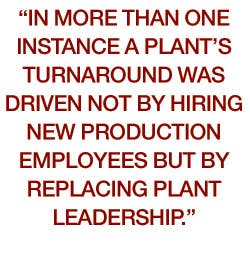Manufacturer's Agenda: Solving Manufacturing's Lesser-Known Workforce Challenge
It's always easy to complain when someone else is to blame. As many manufacturing leaders will tell you, our public K-12 schools need to be fixed; our colleges and universities aren't graduating enough scientists, technologists, engineers and mathematicians; and -- kids these days! -- they just don't seem to get that manufacturing careers are exciting and lucrative.
But what many, if not most, manufacturing leaders aren't doing is looking -- really looking -- at how workforce practices at their own companies discourage the creative contributions of every person they already employ. And, dare I say, that's especially true when it comes to plant floor production employees.
Likewise, it's easier to jump into the fray to help fix those problems caused by other people. Many manufacturing leaders are tackling the aforementioned challenges, lending their expertise to fix the school system, providing grants and scholarships to lure bright students into STEM majors and manufacturing careers, and working to educate students about the vitality of manufacturing today.
But walk into many factories and you'll find knowledge workers whose potential contribution is stymied by the shortsighted stereotypes of their leadership. Yes, those production and skilled workers have brains filled with ideas that can unlock often unbelievable productivity improvements at your plant.
We've seen it happen time and again as we evaluate and select the Annual IndustryWeek Best Plant Award Winners -- see a list of the 2013 IW Best Plants finalists here.
Consistently, we find that plants with production workers in self-directed or empowered work teams have better metrics, and are more productive and profitable than those that don't. On average from 2008 to 2012, winning plants had 65.6% of production employees participating in such work teams.
Often in interviews of IW Best Plant Winners, both leadership and the production teams describe how the plant leadership's renewed efforts to listen to and engage with production employees had been the critical factor in their plant's success.
And, lest you believe that these high-performing plants just got lucky by hiring more highly educated, more cooperative people: In more than one instance a plant's turnaround was driven not by hiring new production employees, but by replacing plant leadership.
| See the IW Best Plants workforce practices stats in a quick-read slideshow format at www.IW.com/IWBestPlants-workforce-stats. |
Having repeatedly heard such stories, I see an overlooked manufacturing workforce challenge -- engaging the untapped ideas and energy of employees working on your factory floor. The good news is: You can find dozens of best practices and strategies in our coverage of the IW Best Plants winners.





